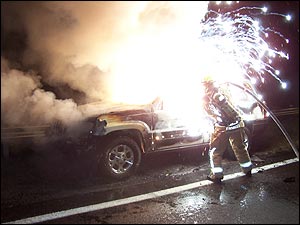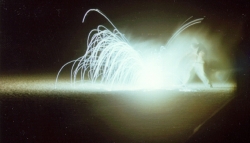|
In an effort to cut the weight
of today's vehicles, manufactures are using a lot of magnesium.
This is a very strong, but light weight metal, weighing only 1/3 the weight of aluminum. Unlike
most metals, this metal burns and is very hard to extinguish.


|
| Click picture to enlarge |
Magnesium fires have a very violent reaction to water, putting
firefighters in much danger.
Click to see REACTION TO WATER
This reaction was from a small piece of magnesium
on the steering column.
We have always known about magnesium in the fire
service, but most firefighters only relate magnesium to the old VW engine, on vehicles. Today we never know where to expect
it, we find it in:
Engine blocks
Valve covers
Intake manifolds
Transmissions
Large truck frames
Truck grilles
Steering columns Wheels
Dash boards
AC parts
F-150 Ford's whole radiator support
Example of Mag. Fire
Magnesium is some what like wood, in that the smaller
the particles, the easier it is to ignite. But unlike wood, magnesium must have its complete surface area heated in order
to ignite. For instance; a piece of magnesium metal shaving will heat all the way around its surface and ignite very rapidly,
while a large piece of plate can actually have a hole burnt in the middle of it with a torch and as the torch is removed the
plate will cool and never ignite, because the whole surface area was not heated.

|
| Click picture to enlarge |
Many scientist disagree on what causes this violent
reaction to water, but the most recognized answer is: (In simple terms)
When heated magnesium ignites and burns with
an intense white light and releases extreme amounts of heat. Most magnesium fires cannot be extinguished by water, since
water reacts with hot magnesium and releases hydrogen.
As we know water expands 1700 times its volume
as it is converted to steam, this in-turn makes the water molecule much smaller and the intense heat from magnesium breaks
them down before they can effectively cool the heat. When broken down these molecules form extreme amounts of hydrogen gas,
which is very explosive. These explosions of hydrogen are then supported by the oxygen, making them even more intense and simply
cause the molten metal to splatter, throwing the small bits of molten metal in all directions.
Warning! Do not look directly into a magnesium fire for long periods of time. The intense light from these fires are
much the same as seen from an arc welder. The fire
is many times brighter than the sun at a normal distance. Please take this seriously, flash blindness is very unpleasant,
it feels like you have sand under your eyelids. A quick one or two second glance every several minutes seems to be okay. This
can be extended slightly if you have welding goggles, or an arc welding mask.
If you do get flash blindness
see a doctor immediately, they can give you the same drugs as those designed for welders who get flash blindness this
will minimize the amount of damage.
IC should immediately evacuate any by standers.
These fire are a beautiful light show that is hard to resist looking at, but this eye damage can occur from a very long
distance if the person continues to watch the fire.
Warning! Structural firefighting gear (PPE)
will not protect a person from a magnesium fire. The sparks that are seen in the pictures are approximately 5400 degrees and
like welder sparks they will collect in the wrinkles of your gear and burn through to your skin before cooling.
Warning! Magnesium produces very
toxic fumes.


A Class D Fire is one that involves combustible metals or combustible metal alloys. There are basically two types of Class D fire extinguishers.
Type 1: The extinguishing agent for type 1 Class D is Sodium Chloride. The type 1 Class D extinguisher is effective at
controlling magnesium, sodium, potassium, sodium potassium alloys,
uranium, and powdered aluminum metal fires.
Type 2: The extinguishing agent for type 2 Class D is a copper
based dry powder. The copper compounds smother the fire and provides an excellent heat sink for dissipating
the heat of the fire.

Video -- Magnesium Identification
Video -- Magnesium Vinegar Test
See -- Full MSDS Sheet
Magnesium plant fire
 . .
|

